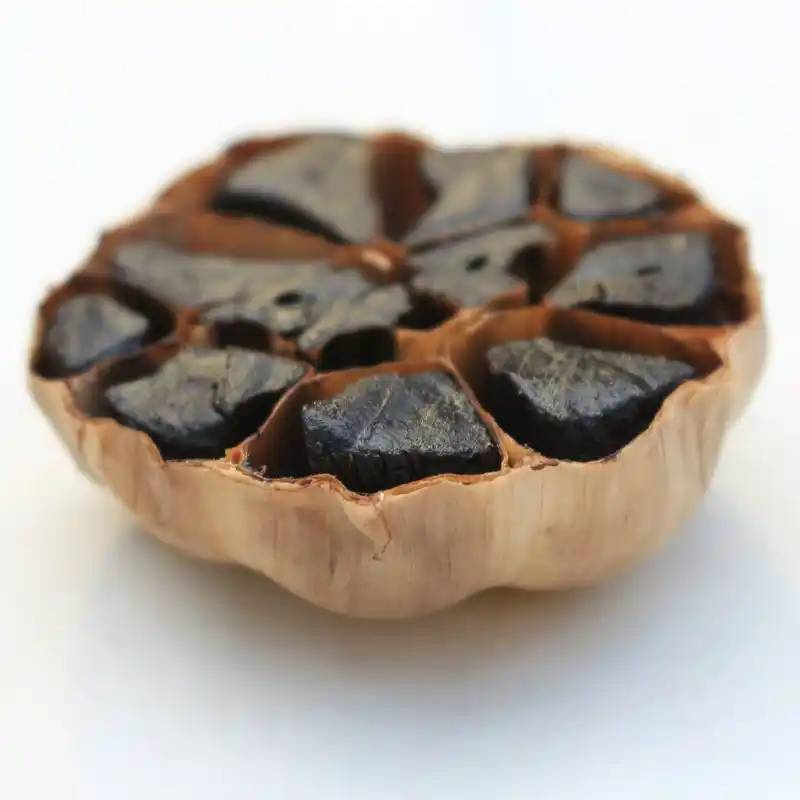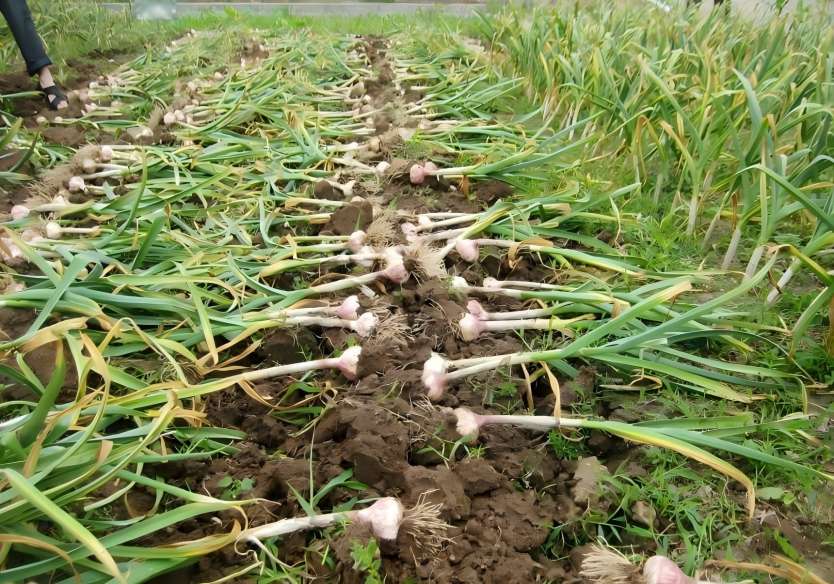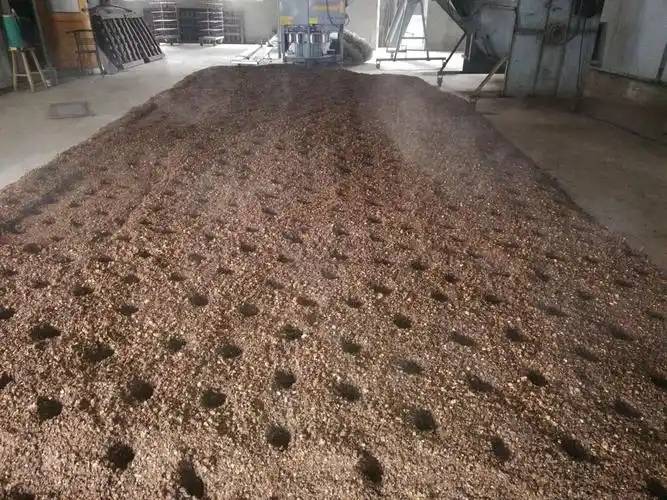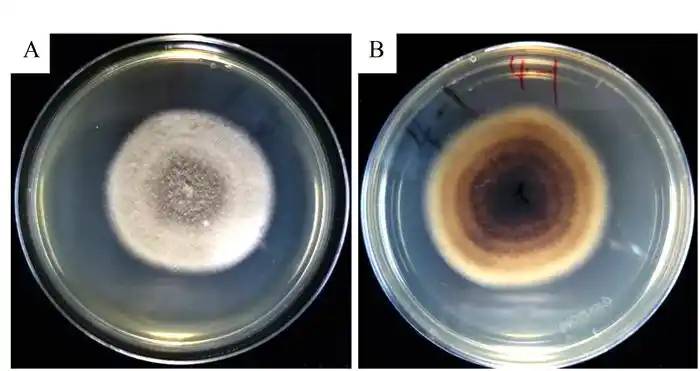Study on the Flavor Change of the Black Garlic Fermentation Process
Garlic is rich in organic sulfur compounds such as allicin and S-allyl-L-cysteine (SAC), which are active ingredients that have antibacterial, antioxidant, anticancer, anti-diabetic and anti-inflammatory effects [1]. However, when the cell structure of garlic is destroyed, these compounds are converted into volatile substances such as allyl methyl sulfide and allyl mercaptan, which give garlic its strong pungent taste and irritating odor [2].
Fermentation can effectively reduce the pungent odor of garlic and also make the texture of garlic softer and chewy, similar to jelly [3]. Black garlic is made by fermenting fresh garlic at high temperatures and high humidity. Studies [4] have found that black garlic can effectively alleviate the symptoms of diabetes patients, and its anti-cancer ability and potential to reduce the risk of cardiovascular disease are even stronger than garlic. This article intends to focus on the changes in chemical composition and flavor compounds during the processing of black garlic, focusing on the key factors that affect its flavor formation, deeply analyze the flavor characteristics of black garlic, and provide a basis for improving the quality of black garlic products.
1 Changes in the main chemical components during the processing of black garlic
Black garlic is a deep-processed garlic product made by fermenting fresh garlic at a certain temperature (50–90°C) and humidity (70%–90%) for a certain period of time [5–7]. This fermentation process involves a variety of chemical reactions, including the Maillard reaction, thermal degradation reaction, oxidation reaction, polymerization reaction, rearrangement reaction, and enzymatic catalysis reaction. These reactions cause changes in the chemical composition, which in turn affect the flavor, color, and nutritional properties of the garlic. In terms of color, fermentation changes garlic from white to black, hence the name black garlic.
As shown in Figure 1, after fermentation, the chemical composition of garlic changes. The content of reducing sugars, organic acids, alkaloids, polyphenols, melanoidins and 5-hydroxymethyl furfural (5-HMF) increases, while the content of moisture, lipids, allicin and polysaccharides decreases [8]. Among these, the increase in polyphenols, 5-HMF, and alkaloids can give black garlic stronger antioxidant, antiviral, and anticancer effects; the decrease in allicin and garlicin can help reduce the pungent smell of black garlic; and the fermentation-derived melanoidins, thiophenes, furans, and pyrazines can give black garlic a unique toasty aroma, sweetness, and caramel flavor [9].
1.1 Changes in organic sulfur compounds
Garlic has a unique pungent aroma, which is mainly attributed to the presence of substances such as allicin and volatile sulfur compounds [10]. As shown in Figure 2, the organic sulfur compounds in garlic are converted by deamidation with the action of γ-glutamyl peptidase to γ-L-glutamyl-S-allyl-L-cysteine, which is converted by deamidation or S-oxidation to SAC or γ-L-glutamyl-S-allyl-L-cysteine-S-oxide, and finally by S-oxidation or deamidation to S-allyl-L-cysteine sulfoxide (allicin) [11]. Allylthiosulphuric acid is a colorless, odorless substance that is produced when garlic is mashed or grated and then hydrolyzed by alliinase to produce dehydroalanine and allyl sulfonate. The two allyl sulfonates then spontaneously condense to form allicin, which is the main source of garlic's pungent odor [12]. Alliin is unstable and can decompose into volatile sulfides such as diallyl sulfide, diallyl disulfide and diallyl trisulfide [13].
Fermentation involves a variety of chemical reactions and can therefore change the flavour of foods [14–16]. During fermentation, heat treatment can lead to the inactivation of allinase, thereby reducing the production of allicin, so that black garlic has no pungent odor [17]. In addition, allicin can be converted by reaction to the stable and odorless S-allyl-L-cysteine (SAMC), which is 6 times higher in black garlic than in garlic [18]. Diallyl disulfide, diallyl trisulfide and dipropyl trisulfide are found in the sulfur compounds of both garlic and black garlic. Only allicin is detected in garlic, while 2-acetyl-1-pyrroline is detected in black garlic [18]; the content of sulfur compounds such as allyl methyl trisulfide, diallyl sulfide, diallyl disulfide and diallyl trisulfide, and other sulfur-containing compounds gradually decrease in black garlic [20].
1.2 Changes in carbohydrates
The carbohydrate content of garlic is about 33%, and it is mainly composed of water-soluble sugars and fructans. The fructans in garlic are keto-sugars composed of fructose and glucose in a ratio of about 14:1 [21]. Garlic polysaccharides are degraded during fermentation to form various monosaccharides (e.g. glucose, fructose, etc.) or disaccharides [22]. Li et al. [23] showed that during the processing of black garlic, the total amount of polysaccharides decreases by about 30%, and is converted into monosaccharide components, mainly fructose, galactose and galacturonic acid, with a molar ratio of 307:25:32. In addition, high temperatures and low pH can promote the hydrolysis of sucrose and produce glucose and fructose, which give black garlic its sweetness [24]. Black garlic also has a sour taste, which is due to the increase in organic acid content during polysaccharide degradation [25].
Carbohydrates are precursors of the Maillard reaction. Amadori (N-substituted 1-amino-1-deoxy-ketose) and Heyns (N-substituted 2-amino-2-deoxy-aldose) are important intermediate products of the Maillard reaction, which are often used to evaluate the degree of Maillard reaction. They are also precursors of the formation of melanoidins.
Amadori and Heyns can also be converted by acid hydrolysis to 2-furanylmethyllysine and 2-furanylmethylamino acids, which are also important indicators for assessing the quality of black garlic [26]. Melanoidins are the end products of the Maillard reaction and are high-molecular-weight brown carbohydrates containing polymerized nitrogen. They are also known as brown pigments and contribute significantly to the browning of black garlic during processing.27 In addition to melanoidins, the Maillard reaction during fermentation can also produce 5-HMF, which can be used to assess the carbohydrate content of foods.28 In addition, 5-HMF can also be formed by caramelization. Zhang et al. [29] pointed out that 5-HMF can affect the color of black garlic. When the 5-HMF content is 4 g/kg, the garlic begins to turn black. The higher the 5-HMF content, the deeper the browning of the black garlic, and too high a 5-HMF content will give the black garlic a bitter taste.
1.3 Changes in other chemical components
The Maillard reaction during black garlic processing can cause protein denaturation and the formation of various amino acids. Under acidic conditions, the Maillard reaction causes the degradation of proteins or peptides by enzymatic or non-enzymatic reactions, which in turn causes an increase in the content of some amino acids in black garlic, such as L-alanine, L-valine, L-isoleucine, L-tyrosine and L-phenylalanine, etc.[24]. Li et al.[23] found that the amino acid content of black garlic samples prepared by freezing pretreatment of garlic was reduced by 50.97%, indicating that the amino acid level of black garlic can vary depending on the processing method.
Lipids can change during the processing of black garlic due to oxidation. After garlic is fermented into black garlic, crude lipids can be converted into compounds such as alcohols, aldehydes, ketones and lactones under high temperature and high humidity conditions, thereby giving black garlic a rich flavor, but the crude lipid content is significantly reduced [30].

2 Changes in characteristic flavor compounds during black garlic processing
In foods, some flavor compounds are defined as characteristic flavor compounds because they give the food a unique aroma [31-38].
Table 1 shows that the green and sulphurous flavours of garlic are more prominent than those of black garlic. Compounds such as diallyl sulphide, 3-vinyl-1,2-thiazole, dimethyl disulphide and dimethyl trisulphide can all contribute to the sulphurous flavour or characteristic garlic flavour of garlic. In black garlic, the content of substances such as roasted and sweet aromas increases, which contributes to the unique sweet and sour flavor of black garlic. Black garlic contains a variety of aroma components such as aldehydes, alcohols, volatile sulfur compounds, ketones and organic acids, while garlic mainly contains volatile sulfur compounds and a small amount of aldehydes and ketones [10].
The volatile sulfides in black garlic, such as 2-vinyl-4H-1,3-dithiophene, allyl methyl trisulfide, diallyl trisulfide, 3-vinyl-1,2-thiazole-4-cyclohexene, and diallyl sulfide, together impart the garlic-like aroma characteristics of black garlic. 3-Vinyl-1,2-thiazol-5-one, diallyl disulfide and diallyl sulfide are characteristic flavour compounds of garlic. Allyl methyl trisulfide and allyl methyl disulfide are flavour compounds common to garlic and black garlic. Volatile sulfur compounds such as allyl trisulfide and diallyl sulfide have a particularly strong aroma due to their low threshold values [34].
In addition to sulfur compounds, heterocyclic compounds are also important aromatic active substances in black garlic. 2(5H)-furanone (burnt), furancarbonal (caramel flavor), 2-acetyl-1-pyrroline (roasted almond flavor), 2-furanylethanone (balsamic vinegar flavor), and 5-heptylidene-2(3H)-furanone (almond flavor) were detected. These compounds are unique to black garlic and are mainly responsible for its toasty aroma and sweetness. In addition, black garlic also contains two unique carbonyl compounds: 1-hydroxy-2-butanone (salty) and 3-methylthiopropanal (cooked potato flavor). The formation of compounds such as allyl alcohol (cooked garlic flavor) and (E,Z)-2,6-nonadien-1-ol (cucumber flavor) also contributes to the unique flavor of black garlic, which is different from that of garlic. Compounds such as 3-methylbutanoic acid (sweaty smell), acetic acid (sour taste) and propionic acid (spicy taste) increase the sourness of black garlic. Fermentation enhances the sour and umami flavours and reduces the salty flavour [37], while significantly reducing the bitter taste of garlic. This change may be related to the decrease in the content of organic sulphur compounds.
3 Factors influencing the flavor characteristics of black garlic
Factors such as garlic variety, planting location, and growing conditions have a significant impact on its quality, which in turn changes the sensory attributes of black garlic [38]. In addition, the nutritional composition of garlic, the processing technology of black garlic (e.g., pretreatment methods, fermentation temperature, fermentation time, and relative humidity), the chemical reactions that occur during processing (e.g., the Maillard reaction), and endophytic bacteria also affect the flavor quality of black garlic [39].
3.1 Nutritional factors
3.1.1 Carbohydrates Fructan is one of the important factors affecting the quality of black garlic. During the processing of black garlic, its fructan content decreases significantly, by 84.6% to 99.2% [40]. The fructose content in black garlic is higher than that of glucose, and fructose is a ketose that participates in the Maillard reaction at a lower rate than glucose, which is an aldose [4]. Therefore, after fermentation, the fructose content of garlic increases to a certain extent, which contributes to the formation of the unique sweet aroma of black garlic [42]. In addition, the formation of the sour taste of black garlic is closely related to the fermentation and degradation of carbohydrates during heat treatment [42]. Fermentation and degradation of carbohydrates can produce organic acids, which can lead to a decrease in pH [42].
3.1.2 Proteins and amino acids
Garlic is rich in protein and essential amino acids. High-temperature processing can denature the protein in black garlic and produce a variety of free amino acids. During the processing of black garlic, amino acids such as tyrosine, arginine and glutamic acid are reduced because they participate in the Maillard reaction to synthesize aroma substances [43]. In addition, the content of branched-chain amino acids such as leucine and isoleucine increases significantly during the processing of black garlic. These free amino acids can undergo a Maillard reaction with sugars to produce a variety of volatile substances [39].
3.2 Quality characteristics
Factors such as garlic variety, growing location, climatic conditions, soil characteristics, rainfall and cultivation management can all affect the quality, aroma and organoleptic properties of garlic and its black garlic products [44]. The quality and physiologically active compounds of garlic from different origins may differ significantly in composition and content [45]. Compared with black garlic fermented from ordinary garlic, black garlic fermented from organic garlic contains more organic sulfur compounds [45], and the content of 5-HMF in black garlic increases with the extension of garlic growth time [6].
3.3 Process factors
3.3.1 Pretreatment methods
Common pretreatment methods include freezing, high pressure and ultrasonic pretreatment, and the influence mechanisms of each pretreatment method are different [46]. Freezing pretreatment can destroy the cell structure of garlic and promote the production of more characteristic flavor compounds, thereby enhancing the sweetness and quality of black garlic. High-pressure pretreatment can help to maintain or enhance specific flavor substances, making the taste of black garlic richer and more balanced. Ultrasonic pretreatment enhances the permeability of the cell walls of garlic through sound energy, which helps to extract and transform the ingredients and promote the formation of aroma and flavor substances.
The SAC content of garlic was increased by 6, 4 and 10 times, respectively, after cryopreservation (-20°C for 30 h), ultrasonic pretreatment (28 kHz for 2 h) and high hydrostatic pressure pretreatment (300 MPa for 15 min) [47]. Compared with cryopreservation and ultra-high pressure pretreatment, ultrasonic pretreatment can significantly enhance the permeability of the garlic cell wall, promote the outflow of more serum γ-glutamyl transpeptidase from the cell and the reaction with γ-L-glutamyl-S-allyl-L-cysteine, resulting in a higher SAC content in the black garlic product [46]. In addition, freezing pretreatment can severely damage the cell structure of garlic, thereby accelerating the Maillard reaction and producing more 5-HMF. The non-thermal effect of ohmic heating (110–130 V, 60–80°C) helps to hydrolyze fructans into fructose, which in turn accelerates the Maillard reaction and increases 5-HMF accumulation [48].
3.3.2 Fermentation temperature
Fermentation temperature has a significant effect on the taste and aroma of black garlic products [29]. As the fermentation temperature increases, the content of aroma precursors such as allicin, SAC and γ-L-glutamyl-S-allyl-L-cysteine gradually decreases [49]. When the fermentation temperature is <60°C, the garlic has not yet completely blackened and its pungent aroma has not yet completely dissipated. When the fermentation temperature is 70°C, the quality and flavour of the black garlic are better [49]. When the fermentation temperature is >90°C, the chemical reactions in the garlic accelerate, the reducing sugar content decreases, and a bitter and burnt flavour may develop, or even harmful substances may form [39]. Under conditions of a fermentation temperature of 75°C and a relative humidity of 85%, the content of aroma precursor substances such as γ-aminobutyric acid, SAC and γ-L-glutamyl-S-allyl-L-cysteine changed most significantly, which helped to enhance the flavor quality of black garlic [50].

3.3.3 Fermentation time
An appropriate fermentation time not only improves the efficiency of chemical reactions, but also enhances the richness of the aroma components of black garlic and maintains a balanced taste. After fermentation at 70–80 °C for 10 days, the content of allicin in garlic decreased from 11.3 g/kg to 2.3 g/kg, and allicin was reduced to an undetectable level [51]. The decrease in allicin was mainly due to its conversion to SAMC, while the decrease in the content of alliin was attributed to its conversion to substances such as diallyl sulfide, diallyl disulfide, and diallyl trisulfide. After 45 days of fermentation at 40 °C, the SAC content in black garlic increased from 19.6 μg/g to 124.7 μg/g [52]. In addition, the glucose and fructose content in black garlic reached a peak on the 45th day of fermentation [9].
3.3.4 Relative humidity
The appearance and browning degree of black garlic are closely related to the relative humidity. High humidity slows down browning, so that black garlic is sweeter and more humid, and the content of organic acids decreases. On the other hand, low humidity may inhibit the chemical reaction and prevent the formation of flavor compounds, resulting in a hard texture [53]. The optimum humidity for black garlic processing is 80% [49]. In addition, the water activity also affects the Maillard reaction, which in turn affects the formation of aroma compounds in black garlic [53].
3.4 Maillard reaction
The Maillard reaction produces various heterocyclic substances such as melanoidins, thiophenes, pyrazines, furans and furanones [54], as well as 5-HMF and other furfural compounds [55]. The flavour compounds produced by the Maillard reaction are mainly responsible for the roasted aroma of black garlic. For example, 2(5H)-furanone produced by the Maillard reaction can give black garlic a toasty aroma, while 3-methylthiopropanal produces a flavour similar to cooked potatoes [10]. The Maillard reaction is closely related to lipid oxidation, and the synergistic reaction between the two promotes the interaction of reaction intermediates, thereby enriching the flavour of black garlic.
Najman et al. [37] identified various flavor compounds in black garlic, such as carbon disulfide, 2-methylthioethanol, 2-methyl-2-propyl mercaptan, 2-octanone, 2-furancarboxaldehyde, α-pinene, 2,3-dimethylpyrazine, 5-methylfurfural and 4-hydroxy-5-methyl-3-furanone, which together give black garlic a complex aroma of toasting, caramel, burning and fruit. In addition, 5-methylfurfural and 2-acetylfuran can give black garlic a unique sweet aroma [3]. The intermediate product of the Maillard reaction, 2-acetylpyrroline, is the main substance that gives black garlic its pleasant aroma [56]. Furfuryl compounds produced by the Maillard reaction have a sweet characteristic and are key markers that distinguish black garlic from garlic [20]. Organic sulfur compounds in garlic are mainly converted into volatile nitrogen-containing compounds such as alkyl sulfides, pyridines, and pyrazines during fermentation, and these compounds do not exist in garlic [12].

3.5 Endophytic bacteria
Endophytic bacteria not only have biological control functions, but also promote plant growth. Spontaneous fermentation of garlic to form black garlic is related to the activity of its endophytic bacteria [57]. Endophytic bacteria can speed up the fermentation of garlic, improve its taste and form more functional compounds, thereby extending the shelf life [58]. Suharti et al. [59] isolated endophytic bacteria such as Erwinia, Pseudomonas, Xanthomonas, Agrobacterium, Rhodostominia, Xylella, Pantoea, Acidiphilus, Burkholderia, Corynebacterium, and Streptomyces, which can promote the degradation of glucose to produce organic acid compounds such as tartaric acid, succinic acid, malic acid, and acetic acid, thereby giving black garlic an acidic taste. In addition, the genus Bacillus, which is also an endophytic bacterium, can promote the conversion of inulin-type fructans to fructose [27]; at the same time, the number of Bacillus species decreases with increasing levels of organic sulfides and 5-HMF.

4 Conclusion
The fermentation process of garlic involves a variety of chemical reactions, which not only help to reduce the pungent odor, but also help to form the unique sweet and sour aroma of black garlic. At the same time, fermentation can promote the formation of more functional active substances in black garlic, which endows it with antioxidant, antiviral and anticancer effects. Therefore, as a deep processing product of garlic, black garlic has good market prospects and development potential. With the development of flavoromics, research on the flavor substances of black garlic has gradually deepened, but there are still many problems. Subsequently, standardized indicators and testing methods for black garlic flavor substances can be established; the production pathways and interactive relationships of characteristic flavor substances in black garlic can be further explored in depth; and the flavor and nutritional quality of black garlic can be precisely controlled according to consumer preferences.
Reference:
[1]VERMA T,AGGARWAL A,DEY P,et al.Medicinal and therapeutic properties of garlic,garlic essential oil,and garlic-based snack food:An updated review[J].Frontiers in Nutrition,2023, 10:1120377.
[2]TEDESCHI P,NIGRO M,TRAVAGLI A,et al.Therapeutic potential of allicin and aged garlic extract in alzheimer's disease[J]. International Journal ofMolecular Sciences,2022,23(13):1374- 1389.
[3]MOLINA-CALLEM,PRIEGO-CAPOTE F,DE CASTROMD L. Headspace-GC-MS volatile profile of black garlic vs fresh garlic: Evolution along fermentation and behavior under heating[J].LWT- Food Science and Technology,2017,80:98-105.
[4]SARYON 0,NANI D,PROVERAWATI A,et al. Immunomodulatory effects of black solo garlic(Allium sativum L.)on streptozotocin-induced diabetesin Wistar rats[J].Heliyon, 2021,7(12):e08493.
[5]MANOONPHOL K,SUTTISANSANEE U,PROMKUM C,et al. Effect of thermal processes on S-allyl cysteine content in black garlic[J].Foods,2023,12(6):1227.
[6]LIU Z,KANG D C,LIXR,et al.Analysis ofvolatile organic compounds in black garlic made of garlic bulbs after harvesting blanched garlic leaves at different growth periods based on PCA and headspace-gas chromatography-ion mobility spectrometry(HS- GC-IMS)[J].Journal of Food Processing and Preservation,2022,46(5):e16550.
[7]TAHIR Z,SAEED F,NOSHEEN F,et al.Comparative study of nutritional properties and antioxidant activity ofraw and fermented (black)garlic[J].International Journal of Food Properties,2022,25(1):116-127.
[8]QIU z C,ZHENG Z J,ZHANG B,et al.Formation,nutritional value,and enhancement of characteristic components in black garlic:A review for maximizing the goodness to humans [J]. Comprehensive Reviews in Food Science and Food Safety,2020,19(2):801-834.
[9]AOUDEH E,OZ E,KELEBEK H,et al.Black garlic production: The influence of ageing temperature and duration on some physicochemical and antioxidant properties,and sugar content[J]. International Journal ofFood Science and Technology,2023,58(7): 3.580-3590.
[10]YANG P,SONG HL,WANG L J,et al.Characterization of key aroma-active compounds in black garlic by sensory-directed flavor analysis[J].Journal of Agricultural and Food Chemistry,2019,67(28):7926-7934.
[11]WAKAMATSU J,STARK TD,HOFMANN T.Taste-active Maillard reaction products in roasted garlic(Allium sativum)[J]. Journal of Agricultural and Food Chemistry,2016,64(29):5845-5854.
[12]ABE K,HORI Y,MYODA T.Characterization of key aroma compounds in aged garlic extract [J].Food Chemistry,2020, 312:126081.
[13]ABE K,HORI Y,MYODA T.Volatile compounds of fresh and processed garlic[J].Experimental and Therapeutic Medicine,2020, 19(2):1585-1593.
[14]HOUXY,WANG JH,DENGN,et al.Research progress on the effect of lactic acid bacteria on the flavor of the fermented vegetables[J].Food &Machinery,2023,39(4):232-240.
[15]GUANQQ,XIONG T,XIEMY.Research progress in lactic acid bacteria fermentation technology ofplant-based foods[J].Journal of Food Science and Biotechnology,2022,41(7):1-11.
[16]LIU M,DENG N,LI H,et al.Characterization and comparison of flavors in fresh and aged fermented peppers:Impact of different varieties[J].Food Research International,2024,182:114187.
[17]TURAN E,SIMSEK A.Black garlic as a substitute for fresh garlic to reduce off-flavor and enhance consumer acceptance and bioactive properties in cemen paste[J].Journal of Food Processing and Preservation,2022,46(2):e16246.
[18]CHEN ZX,XUM J,WANG C,et al.Thermolysis kinetics and thermal degradation compounds of alliin[J].Food Chemistry,2017,223:25-30.
[19]CZOMPAA,SZOKE K,PROKISCH J,et al.Aged(black)versus raw garlic against ischemia/reperfusion-induced cardiac complications[J].International Journal of Molecular Sciences, 2018,19(4):1017.
[20]MARTINEZ-CASAS L,LAGE-YUSTY M, LÓPEZ- HERNANDEZ J.Changes in the aromatic profile,sugars,and bioactive compoundswhen purple garlic is transformed into black garlic[J].Journal of Agricultural and Food Chemistry,2017,65
(49):10804-10811.
[21]YUAN H,SUN L,CHEN M,et al.An analysis of the changes on intermediate products during the thermal processing of black garlic [J].Food Chemistry,2018,239:56-61.
[22]LINY,LUXM,PEI HB,et al.Effect of freezing pretreatment on the processing time and quality of black garlic[J].Journal of Food Process Engineering,2015,38(4):329-335.
[23]LI M,YANYX,YUQT,et al.Comparison of immunomodulatory effects of fresh garlic and black garlic polysaccharides on raw 264.7 macrophages[J].Journal of Food Science,2017,82(3):765-771.
[24]LIANG TF,WEI FF,LU Y,et al.Comprehensive NMR analysis of compositional changes of black garlic during thermal processing[J]. Journal ofAgricultural and Food Chemistry,2015,63(2):683-691.
[25]AHMED T,WANGCK.Black garlic and its bioactive compounds on human health diseases:A review[J].Molecules,2021,26(16):5028.
[26]ANDRUSZKIEWICZ PJ,D'SOUZA RN,CORNO M,et al. Novel Amadori and Heyns compounds derived fromshort peptides found in dried cocoa beans[J].Food Research International,2020, 133:109164.
[27]QIU Z,ZHENG Z,ZHANG B,et al.Characterization of the growth properties of garlic endophytes and their roles in the formation of black garlic[J].LWT-Food Science and Technology, 2021,147:111537.
[28]HU H,WANG Y,SHEN M,et al.Effects of baking factors and recipes on the quality of butter cookies and the formation of advanced glycation end products(AGEs) and 5- hydroxymethylfurfural(HMF)[J].Current Research in Food Science,2022,5:940-948.
[29]ZHANGXY,LINY,LUXM,et al.Effects of temperature on the quality of black garlic [J].Journal of Agricultural and Food Chemistry,2016,96(7):2366-2372.
[30]ZAMORA R,HIDALGO F J.Coordinate contribution of lipid oxidation and Maillard reaction to the nonenzymatic food browning[J].Critical Reviews in Food Science and Nutrition,2005, 45(1):49-59.
[31]MENG X R,GAO z W,WANG H P,et al.Construction of evaluation model of volatile flavor intensity of cyclic stewed beef based on principal component analysis[J].Food &Machinery, 2022,38(10):29-36.
[32]ZHAO X,YU PH,HUANG H,et al.Investigated by HS-GC- IMMS influence of drying method on volatile flavor substances of raw dark tea[J].Journal of Food Science and Biotechnology,2022, 41(9):104-111.
[33]ZHANG R R,YUXW,OUYANG H,et al.Combination of HS- SPME-GC-O-MS and E-nose revealed the characteristic aroma differences of watermelon seeds under various thermal processing treatments[J].Food &Machinery,2023,39(1):917.
[34]CUI YW,LIU L X,ZHANG L Y,et al.Geographical differentiation of garlic based on HS-GC-IMS combined with multivariate statistical analysis[J].Analytical Methods,2024,16(3):465-473.
[35]MAY K,SONG D D,WANG ZF,et al.Effect ofultrahigh pressure treatment on volatile compounds in garlic[J].Journal of Food Process Engineering,2011,34(6):1915-1930.
[36]ABE K,MYODA T,NOJIMA S.Identification and characterization of sulfur heterocyclic compounds that contribute to the acidic odor of aged garlic extract[J].Journal of Agricultural and Food Chemistry,2021,69(3):1020-1026.
[37]NAJMAN K,KROL K,SADOWSKA A.The physicochemical properties,volatile compounds andtaste profile of black garlic (Allium sativum L.)cloves,paste and powder [J].Applied Sciences-Basel,2022,12(9):4215.
[38]MARTINS N,PETROPOULOS S,FERREIRA I.Chemical composition and bioactive compounds of garlic(Allium sativum L.)as affected by pre and post-harvest conditions:A review[J].Food Chemistry,2016,211:41-50.
[39]BEDRNICEK J,LAKNEROVAI,LORENC F,et al.The use of a thermal process to produce black garlic:Differences in the physicochemical and sensory characteristics using seven varieties of fresh garlic[J].Foods,2021,10(11):2703.
[40]YUAN H,SUN L J,CHEN M,et al.The comparison of the contents of sugar,Amadori,and Heyns compounds in fresh and black garlic[J].Journal of Food Science,2016,81(7):1662-1668.
[41]RIOS-RIOS K L,MONTILLA A,OLANO A,et a. Physicochemical changes and sensorial properties during black garlic elaboration:A review [J].Trends in Food Science & Technology,2019,88:459-467.
[42]NAJMAN K,SADOWSKA A,HALLMANN E.Influence of thermal processing on the bioactive,antioxidant,and physicochemical properties of conventional and organic agriculture black garlic(Allium sativum L.)[J].Applied Sciences- Basel,2020,10(23):8638.
[43]LIU CF,LULD,YANGCJ,et al.Effects of thermal treatment on allin and its related sulfides during black garlic processing[J]. LWT-Food Science and Technology,2022,159:113158.
[44]JAVED M,AHMED W.Black garlic:A review of its biological significance [J].Journal of Food Biochemistry,2022,46(12):e14394.
[45]SASMAZ H K,SEVINDIK O,ADAL E,et al.Comparative assessment of quality parameters and bioactive compounds of white and black garlic[J].European Food Research and Technology,2022,248(9):2393-2407.
[46]CHAN K H,CHANGCK,GAVAHIAN M,et al.The impact of different pretreatment processes(freezing,ultrasound and high pressure)on the sensory and functional properties of black garlic (Allium sativum L)[J].Molecules,2022,27(20):6992.
[47]CHENY T,CHENYA,LEE CH,etal.A strategy for promoting Y-glutamyltransferase activity and enzymatic synthesis of S-allyl-(L)-cysteine in aged garlic via high hydrostatic pressure pretreatments[J].Food Chemistry,2020,316:126347.
[48]RIOS-RIOS K L,GAYTAN-MARTINEZ M,RIVERA- PASTRANADM,et al.Ohmic heating pretreatment accelerates black garlic processing[J].LWT-Food Science and Technology, 2021,151:112218.
[49]LIUCF,LULD,YANGCJ,et al.Effects of thermal treatment on alliin and its related sulfides during black garlic processing[J]. LWT-Food Science and Technology,2022,159:113158.
[50]WU P,LIU P X,WANGY T,et al.Changing pattern of characteristic components in black garlic during processing analyzed by ultra-high performance liquid chromatography-triple quadrupole tandem mass spectrometry[J].Food Science,2024,45 (1):82-90.
[51]ZHANG Z S,LEI M M,LIU R,et al.Evaluation of allin, saccharide contents and antioxidant activities of black garlic during thermal processing[J].Journal of Food Biochemistry,2015, 39(1):39-47.
[52]BAE SE,CHOSY,WON Y D,et al.Changes in S-allyl cysteine contents and physicochemical properties of black garlic during heat treatment[J].LWT-Food Science and Technology,2014,55 (1):397-402.
[53]AFZAAL M,SAEED F,RASHEED R,et al.Nutritional, biological,and therapeutic properties of black garlic:A critical review[J].International Journal Food Properties,2021,24(1): 1387-1402.
[54]DING YF,ZHOUXF,ZHONG Y,et al.Metabolite,volatile and antioxidant profiles of black garlic stored in different packaging materials[J].Food Control,2021,127:108131.
[55]WANG CC,ZHENG Z J,LUXM,et al.Formation and safety evaluation of5-hydroxymethylfurfural in black garlic[J].Food Science,2022,43(3):100-105.
[56]LUXM,LINY,QIAOXG,et al.Composition analysis and antioxidant properties of black garlic extract[J].Journal of Food and Drug Analysis,2017,25(2):340-349.
[57]LU X,LI N,QIAO X,et al.Effects of thermal treatment on polysaccharide degradation during black garlic processing[J]. LWT-Food Science and Technology,2018,95:223-229.
[58]UTAMA GL,RAHMI Z,SARIM P,et al.Psychochemical changes and functional properties of organosulfur and polysaccharide compounds of black garlic(Alliumsativum L.)[J]. Current Research in Food Science,2024,8:100717.
[59]SUHARTIARLSWS.Analysis oftotal acidity toward bacterial and endophytic fungi profile during black garlicprocessing from garlic(Allium sativum L.)and shallot(Allium ascalonicum L.) [J].Makara Journal of Science,2021,25(3):188-194.


 English
English French
French Spanish
Spanish Russian
Russian Korean
Korean Japanese
Japanese



